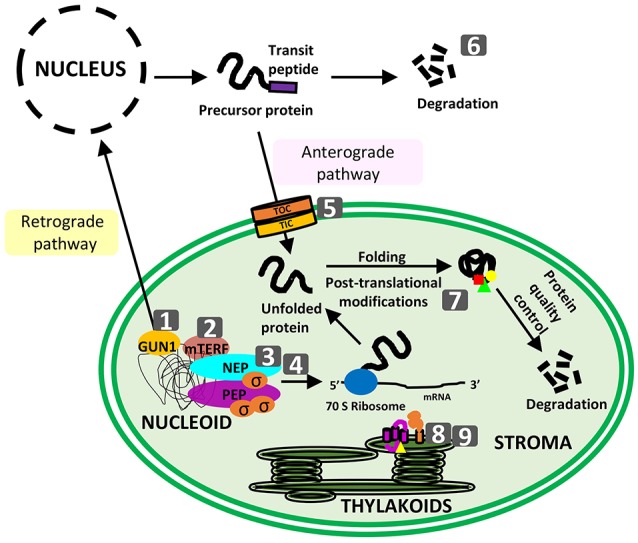Figure 1.

Schematic representation of topics covered in the special issue. Numbers correspond to the following articles: (1) !https://doi.org/10.3389/fpls.2016.01427!!Colombo et al.!!! GUN1, a jack-of-all-trades in chloroplast protein homeostasis and signaling; (2) !https://doi.org/10.3389/fpls.2017.01213!!Xu et al.!!! Arabidopsis thaliana mTERF10 and mTERF11, but not mTERF12, are involved in the response to salt stress; (3) !https://doi.org/10.3389/fpls.2017.00023!!Liebers et al.!!! regulatory shifts in plastid transcription play a key role in morphological conversions of plastids during plant development; (4) !https://doi.org/10.3389/fpls.2017.01186!!Shimmura et al.!!! comparative analysis of chloroplast psbD promoters in terrestrial plants; (5) !https://doi.org/10.3389/fpls.2017.00168!!Sjuts et al.!!! import of soluble proteins into chloroplasts and potential regulatory mechanisms; (6) !https://doi.org/10.3389/fpls.2017.00310!!Hirosawa et al.!!! ubiquitin-proteasome-dependent regulation of bidirectional communication between plastids and the nucleus; (7) !https://doi.org/10.3389/fpls.2017.00240!!Grabsztunowicz et al.!!! post-translational modifications in regulation of chloroplast function: recent advances; (8) !https://doi.org/10.3389/fpls.2017.01313!!Gabilly and Hamel!!!, maturation of plastid c-type cytochromes; (9) !https://doi.org/10.3389/fpls.2017.01306!!Cline et al.!!! CCS2, an octatricopeptide-repeat protein, is required for plastid cytochrome c assembly in the green alga Chlamydomonas reinhardtii.
